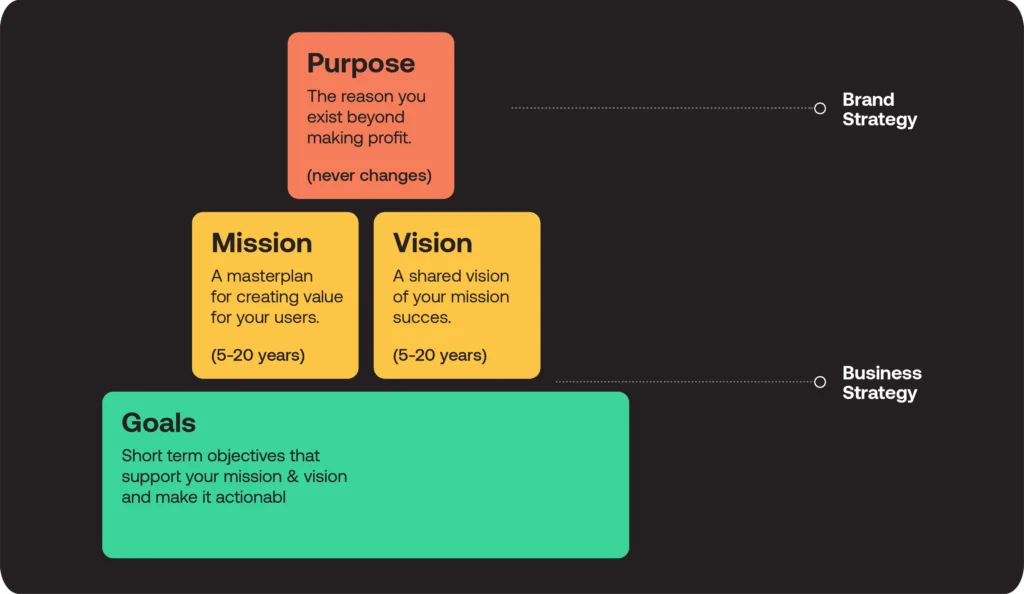Terms like “brand strategy” and “business strategy” are often tossed around with little regard for their nuanced differences and interdependencies. But understanding these terms is not just a matter of semantics; it’s a crucial factor for any business aiming for long-term success. In this article, we will dive a bit deeper into the relationship the two have and how they are linked together.
The Cornerstone of Success
Traditionally, business strategy has been considered the cornerstone upon which all other organizational elements are built. Not something that is a “nice-to-have”; it’s your survival kit. It’s the roadmap that takes you from being a garage startup, to a market leader. But I am here to make the case, that we have been looking at this all wrong. It’s actually your brand strategy that should be the starting point, the catalyst that fuels not just incremental changes but transformative shifts in your business.
What is a Business Strategy?
Let’s start with defining what a business strategy is; a calculated blueprint for how you’re going to win this game. For SaaS startups and scaleups, this means a laser focus on metrics like Monthly Recurring Revenue (MRR), Customer Lifetime Value (CLV), and the ever-dreaded Churn Rate. Your strategy is your game plan for how you’ll allocate resources, what markets you’ll penetrate, and how you’ll deal with competitors who would love to see you fail.
- Mission and Vision: This is your North Star. What problem does your software solve, what do you stand for and where do you see your company in 5 or 10 years?
- Market Analysis: Know your playground. Who are your customers, and why should they care about you instead of your competitors?
- Objectives and Goals: These are your battle tactics. What are the specific, measurable outcomes you’re gunning for?
- Product Strategy: This is your arsenal. What features will make your software indispensable, and how will you price it to maximize revenue and market penetration?
- Sales and Distribution: These are your supply lines. How will you get your product into the hands of customers?
- Customer Retention: This is your defensive strategy. How will you keep customers from defecting to the enemy?
- Resource Allocation: This is your logistics. What resources will you deploy where?
- Risk Assessment: These are your contingency plans. What’s your Plan B for when things go south?
- Monitoring and KPIs: These are your reconnaissance. How will you know if you’re winning or losing?

The Brand at the Core of Business Strategy
Your brand isn’t just a logo or a catchy slogan; it’s the DNA of your organization. It’s your values, your purpose, and your promise to your customers. It’s what you stand for and what sets you apart in a crowded marketplace. When you start with a strong brand strategy, you’re laying a foundation that is authentic to what your organization is and aspires to be. Effectively it’s what positions you uniquely in the market, at it’s core.
The Domino Effect
Imagine your brand strategy as the first domino in a long chain. Once it’s set in the right place and given the initial push, it sets off a series of events that are not only aligned but also gain momentum as they go along. Your brand strategy informs your business goals, which in turn guide your operational strategies, your marketing campaigns, and even your hiring decisions. Everything becomes interconnected and purpose-driven.
When your brand strategy leads, it informs your product development, your market positioning, and your customer engagement. You’re not just pushing features; you’re fulfilling a promise. You’re not just selling a service; you’re providing an experience. And that, is how you build a business that lasts.
The Power of Alignment
When your brand strategy leads the way, every business decision you make is aligned with your core values and customer promise. This creates a cohesive and authentic customer experience at every touchpoint, from the first ad they see to the customer service they receive. This alignment isn’t just good for the customer; it’s good for the business. It streamlines decision-making, reduces internal conflicts, and improves efficiency.
The Risk of Misalignment
Without a leading brand strategy, businesses often find themselves in a reactionary position, adapting to market trends and competitor moves without a guiding principle. A well-executed brand strategy has the power to transform not just your marketing efforts but your entire business. It can help you pivot in a new direction, enter new markets, or even redefine an industry.
If you start with a business strategy, you risk building a product that’s disconnected from your brand promise. And that’s a recipe for internal, external confusion and, ultimately, business failure. You might have the best features, but if they don’t align with what your brand stands for, you’re just another commodity in a crowded market. It’s all about communication, visually and verbally.
Good Strategy, Bad Strategy
A good strategy isn’t a collection of buzzwords or a to-do list dressed up in a suit and tie. It’s a diagnosis of the real challenge you’re facing, a guiding policy to tackle it, and a set of coherent actions to make that policy a reality. Sounds straightforward, right? But most businesses are wandering around in a fog of vagueness, mistaking poorly defined objectives for strategy.
Lack of Focus and Poor Implementation
A lack of focus is often the byproduct of leadership that’s acting like a kid in a candy store—everything looks good, so they want it all. The result? A diluted effort that’s spread so thin it makes tissue paper look like a wooden panel. And then there’s poor implementation, whether it’s because you’re strapped for resources, lack the necessary expertise, or simply dropped the ball, poor implementation and the absence of steering the ship in time will render any strategy useless.
A Remedy to Lack of Focus:
- Set Clear Objectives: Ensure that your strategy has clear, measurable objectives. Use SMART goals (Specific, Measurable, Achievable, Relevant, Time-bound) to provide a clear direction.
- Prioritize: Not all objectives are created equal. Use a prioritization framework like the Eisenhower Matrix to categorize tasks into urgent/important matrices.
- Allocate Resources: Ensure that you have the necessary resources—be it time, manpower, or capital—to implement your strategy effectively.
- Regular Monitoring: Use KPIs to regularly monitor progress. If certain aspects are falling short, identify the bottlenecks and address them promptly.
The Convergence: Brand Strategy as the Lens for Business Strategy
Where brand strategy comes into play is in its ability to serve as the lens through which a business strategy is viewed. Far from being a mere subset of business strategy, brand strategy is a critical component that can either make or break a business’s success.
Take Apple, for instance. Their brand strategy of innovation and user-friendly design isn’t just marketing talk; it’s the core of their business strategy. It informs the products they develop, the way they market them, and even the layout of their stores. Or consider Tesla, whose brand promise of accelerating the world’s transition to sustainable energy is intrinsically tied to their business strategy, from product development to marketing. In essence, a well-aligned brand strategy not only firstly informs but also amplifies a business strategy.
Embracing the Pivot
The marketplace is a living, breathing entity. It shifts, it evolves, and if you’re not careful, it’ll leave you behind. That’s where the importance of regular evaluation comes into play. You can’t just set a course and assume you’re going to reach your destination. You’ve got to keep your eyes on the road and be ready to adjust course when an obstacle appears out of nowhere.
Internally, you’ve got metrics. These are your dashboard lights, warning you when something isn’t going the way it should or confirming that you’re in the right direction. Externally, you’ve got market trends, customer feedback, and competitor moves—these are your road signs, your GPS, telling you what’s up ahead. Ignoring these indicators is like driving blindfolded; you’re setting yourself up to crash.
Be as water my friend
There is a conventional path when we’re talking about strategy. You start by assessing your current position, then you research the market, envision potential scenarios, and so on. You tick off these tasks one by one, each building on the last, like laying bricks to pave your road to success. It’s a linear journey, and there’s comfort in its predictability. But, we’re not living in a linear world.
So, what if we shook things up a bit? What if, instead of treating these steps like a checklist, we treated them like an ecosystem—interconnected, dynamic, and constantly influencing each other? That’s where agile strategy comes into play, a methodology we’ve honed to a fine art at Upmarch. It’s not just about working faster; it’s about working smarter, more collaboratively, and with a level of adaptability that traditional models just can’t offer.
Imagine your strategy as a living, breathing entity, existing in a perpetual “liquid state.” It’s constantly adapting, morphing, and responding to both internal metrics and external market signals. This dynamic approach allows agile teams to build and scale a brand in a fraction of the time it would take using conventional methods. This keeps the core of your original vision not just intact but vibrant, allowing tasks to inform and influence one another in real-time. Read more about this framework here.
The Bottom Line, your Brand as the Biggest Differentiator
So, what’s the takeaway? Strategy isn’t just about what you’re going to do; it’s about what you’re not going to do. It’s about making choices, setting priorities, and sticking to them. It’s about aligning your team, your resources, and your actions to achieve a clearly defined objective. And most importantly, it’s about having the discipline to execute that strategy, come hell or high water.
The Brand Strategy defines the purpose, values, and positioning of the brand, while the Business Strategy outlines the overall direction, goals, and operational plans. By aligning these strategies, both start-ups scale-ups can establish a clear and compelling vision that guides all aspects of their operations, ensuring a consistent and impactful (brand) experience and crystal clear means of growing upwards.
In a world where consumers are bombarded with choices, a strong brand can be your biggest differentiator. But it’s not just about standing out; it’s about standing for something. When your brand strategy is your starting point, it becomes the catalyst that fuels your business transformation, guiding each decision you make and ensuring that your business is always moving in the right direction. So, don’t just think of your brand as a business asset; think of it as your business’s North Star, It’s Guiding Principles.




